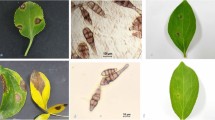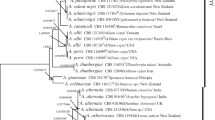Abstract
Two Alternaria species were isolated from two Solanaceae plants in China, 2017. Both were determined based on morphological characteristics and multigene sequence analysis of the internal spacer rDNA region (ITS), translation-elongation factor 1 alpha (TEF1), glyceraldehydes-3-phosphate dehydrogenase (GAPDH), Alternaria major allergen gene (ALT), and RNA polymerase second largest subunit (RPB2). One species from Solanum tuberosum was identified as Alternaria blumeae, and another from Physalis alkekengi was described as a new species. Alternaria blumeae is firstly reported from S. tuberosum in China. The new species was described and illustrated here, as Alternaria physalidis sp. nov. It is clearly distinct from the phylogenetically related species, A. zinniae, in the conidial body length and number of septa.



Similar content being viewed by others
References
Ayad D, Leclerc S, Hamon B, Kedad A, Bouznad Z, Simoneau P (2017) First report of early blight caused by Alternaria protenta on potato in Algeria. Plant Dis 101:836
Ayad D, Hamon B, Kedad A, Bouznad Z, Simoneau P (2018) First report of early blight caused by Alternaria linariae on potato in Algeria. Plant Dis 102:2651
Bai JK (2003) Flora fungorum sinicorum. In: Sphaeropsidales, Ascochyta, Septoria, vol 17. Science Press, Beijing, p 372
Berbee ML, Pirseyedi M, Hubbard S (1999) Cochliobolus phylogenetics and the origin of known, highly virulent pathogens, inferred from ITS and glyceraldehyde-3-phosphate dehydrogenase gene sequences. Mycologia 91:964–977
Carbone I, Kohn LM (1999) A method for designing primer sets for speciation studies in filamentous ascomycetes. Mycologia 91:553–556
Carson ML (1987) Effects of two foliar pathogens on seed yield of sunflower. Plant Dis 71:549–551
Cenis J (1992) Rapid extraction of fungal DNA for PCR amplification. Nucleic Acids Res 20:2380
Chun J (1995) Computer-assisted classification and identification of actinomycetes. Dissertation, Unversity of Newcastle
Deng JX, Li MJ, Paul NC, Oo MM, Lee HB, Oh SK, Yu SH (2018) Alternaria brassicifolii sp. nov. isolated from Brassica rapa subsp. pekinensis in Korea. Mycobiology 46:1–5
Ellis MB (1972) Dematiaceous hyphomycetes. XI. Mycol Pap 131:1–25
Fukushima A, Nakamura M, Suzuki H, Yamazaki M, Knoch E, Mori T, Umemoto N, Morita M, Hirai G, Sodeoka M, Saito K (2016) Comparative characterization of the leaf tissue of Physalis alkekengi and Physalis peruviana using RNA-seq and metabolite profiling. Front Plant Sci 7:1883
Gannibal PB (2015) Distribution of Alternaria species among sections. 1. Section Porri. Mycotaxon 130:207–213
Hall TA (1999) BioEdit: a user-friendly biological sequence alignment editor and analysis program for Windows 95/98/NT. Nucleic Acids Symp Ser 41:95–98
Hong GS, Cramer RA, Lawrence CB, Pryor BM (2005) Alt a 1 allergen homologs from Alternaria and related taxa: analysis of phylogenetic content and secondary structure. Fungal Genet Biol 42:119–129
Lawrence DP, Park MS, Pryor BM (2012) Nimbya and Embellisia revisited, with nov. comb. for Alternaria celosiae and A. perpunctulata. Mycol Prog 11:799–815
Lawrence DP, Gannibal PB, Peever TL, Pryor BM (2013) The sections of Alternaria: formalizing species-group concepts. Mycologia 105:530–546
Lawrence DP, Gannibal PB, Dugan FM, Pryor BM (2014) Characterization of Alternaria isolates from the infectoria species-group and a new taxon from Arrhenatherum, Pseudoalternaria arrhenatheria sp. nov. Mycol Prog 14:257–276
Lawrence DP, Rotondo F, Gannibal PB (2016) Biodiversity and taxonomy of the pleomorphic genus Alternaria. Mycol Prog 15:3
Liu YJ, Whelen S, Hall BD (1999) Phylogenetic relationships among ascomycetes: evidence from an RNA polymerse II subunit. Mol Biol Evol 16:1799–1808
McKenzie EHC, Dingley JM (1996) New plant disease records in New Zealand: miscellaneous fungal pathogens III. NZ J Bot 34:263–272
Nylander JAA (2004) MrModeltest v2. Program distributed by the author. Evolutionary Biology Centre, Uppsala University
Pryor BM, Gilbertson RL (2000) Molecular phylogenetic relationships amongst Alternaria species and related fungi based upon analysis of nuclear ITS and mt SSU rDNA sequences. Mycol Res 104:1312–1321
Rahman MZ, Uematsu S, Suga H, Kageyama K (2015) Diversity of Phytophthora species newly reported from Japanese horticultural production. Mycoscience 56:43–459
Rambaut A, Drummond A (2010) FigTree v.1.3.1. Institute of Evolutionary Biology. University of Edinburgh, Edinburgh
Rayner RW (1970) A mycological colour chart. Commonwealth Mycological Institute, Kew
Ronquist F, Huelsenbeck JP (2003) MrBayes 3: Bayesian phylogenetic inference under mixed models. Bioinformatics 19:1572–1574
Simmons EG (1992) Alternaria taxonomy: current status, viewpoint, challenge. In: Chelkowski J, Visconti A (eds) Alternaria: biology, plant diseases and metabolites. Elsevier, Amsterdam, pp 9–107
Simmons EG (1997) Alternaria themes and variations (151–223). Mycotaxon 65:1–91
Simmons EG (2000) Alternaria themes and variations (244–286) species on Solanaceae. Mycotaxon 75:1–115
Simmons EG (2007) Alternaria an identification manual. CBS Fungal Biodiversity Centre, Utrecht, pp 10–12
Stamatakis A (2006) RAxML-VI-HPC: maximum likelihood–based phylogenetic analyses with thousands of taxa and mixed models. Bioinformatics 22:2688–2690
Sung GH, Sung JM, Hywel-Jones NL, Spatafora JW (2007) A multi–gene phylogeny of Clavicipitaceae (Ascomycota, fungi): identification of localized incongruence using a combinational bootstrap approach. Mol Phylogenet Evol 44:1204–1223
Swofford DL (2003) PAUP*: phylogenetic analysis using parsimony, * and other methods. Version 4.0b10. Sinauer Associates, Sunderland
Tamura K, Stecher G, Peterson D, Filipski A, Kumar S (2013) MEGA6: molecular evolutionary genetics analysis version 6.0. Mol Biol Evol 30:2725–2729
Thomma BP (2003) Alternaria spp.: from general saprophyte to specific parasite. Mol Plant Pathol 4:225–236
White TJ, Bruns T, Lee S, Taylor J (1990) Amplification and direct sequencing of fungal ribosomal RNA genes for phylogenetics. In: Innis MA, Gelfand DH, Sninsky JJ (eds) PCR protocols: a guide to methods and applications. Academic Press Inc, New York, pp 315–322
Woudenberg JHC, Groenewald JZ, Binder M, Crous PW (2013) Alternaria redefined. Stud Mycol 75:171–212
Woudenberg JHC, Truter M, Groenewald JZ, Crous PW (2014) Large spore Alternaria pathogens in section Porri disentangled. Stud Mycol 79:1–47
Zhang TY (2003) Flora fungorum sinicorum, Alternaria, vol 16, 1st edn, Beijing, pp 55–61
Acknowledgments
The authors sincerely thank Prof. Jian Ma for the assistance on nomenclature of the new species.
Funding
The financial support of the work was given by the National Natural Science Foundation of China (31400014) and the Young Scientist Foundation of Yangtze University (2016cqr08).
Author information
Authors and Affiliations
Corresponding author
Additional information
Editorial Responsibility: Gerhard Rambold
Publisher’s note
Springer Nature remains neutral with regard to jurisdictional claims in published maps and institutional affiliations.
Rights and permissions
About this article
Cite this article
Liu, H.F., Liao, J., Chen, X.Y. et al. A novel species and a new record of Alternaria isolated from two Solanaceae plants in China. Mycol Progress 18, 1005–1012 (2019). https://doi.org/10.1007/s11557-019-01504-3
Received:
Revised:
Accepted:
Published:
Issue Date:
DOI: https://doi.org/10.1007/s11557-019-01504-3




